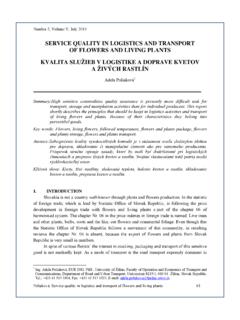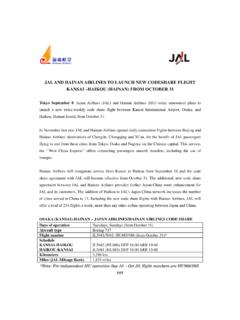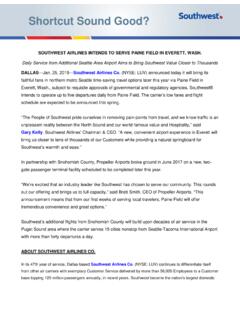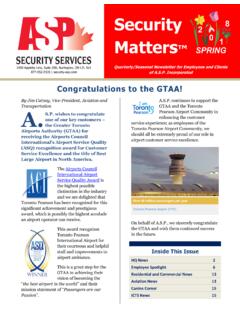Transcription of HOW TO IMPROVE AIRPORT OPERATION - Univerzita …
1 Number 5, Volume VI, December 2011 Kazda, Hrom dka: How to IMPROVE AIRPORT OPERATION 118 HOW TO IMPROVE AIRPORT OPERATION Anton n Kazda1, Martin Hrom dka2 Summary: This paper discusses AIRPORT operational performance issue. The focus is on research executed to find out which areas need to be improved in the AIRPORT operations in near future. Also, features of IT solutions for achieving better process control and the overall performance are briefly described. This paper is a part of project Centre of Excellence for Air Transport ITMS 26220120065. Key words: AIRPORT OPERATION , performance, control process, IT solution As air traffic continues to grow, fuel prices rise, security remains strict and capacity is stretched to the limit, the need for efficient AIRPORT operations is at an all-time high. The problems created by poorly run systems are felt by everyone involved in air travel in terms of delayed flights, long queues, lost baggage, wasted time and rising costs.
2 From this point of view, the AIRPORT OPERATION seems to be critical in the whole industry. Time is money. Every single airline is aware of this well known fact. Time is a critical value. Especially time spent on the ground during handling procedure. This period does not allow an airline to generate any revenues. Revenues can be generated only when the aircraft is in the air. Therefore is reducing of non-productive period spent on the apron one of the biggest challenges which airlines are facing in these days when the market is oversaturated with competition. Reducing stay on the ground means possibility of adding additional frequency for an aircraft flying on short or medium-haul routes. Consequences of this step are obvious. From marketing point of view, more frequencies means more attractive schedule, more attractive schedule means competitive advantage. From economic point of view, more frequencies means more passengers, more passengers means more revenues.
3 1. CURRENT TRENDS As long as current trends, let us have a look at UK example. Background research on industry and business trends forecasts a 140 % increase in annual UK passenger traffic in the first thirty years of this century, from 200 million in 2002 to 485 million by 2030. A significant portion of that traffic (275 million passengers) is expected to migrate to low cost 1 Prof. Ing. Anton n Kazda, PhD., University of ilina Faculty of Transport and Communication, Air transport department,Univerzitna 1, 010 26 ilina, Slovakia, Tel.: +421415133451, E-mail: 2 Ing. Martin Hrom dka, University of ilina Faculty of Transport and Communication, Air transport department,Univerzitna 1, 010 26 ilina, Slovakia, E-mail: INTRODUCTION Number 5, Volume VI, December 2011 Kazda, Hrom dka: How to IMPROVE AIRPORT OPERATION 119 airlines , which have experienced a sustained 9% annual growth in the volume of flights in recent years.
4 This trend signals an increase in demand for the 30 minutes turn-around, represents mostly business travellers that put a high value on their time, and aggravates the pressure for punctuality and efficiency on AIRPORT operations . Furthermore, the introduction of larger aircraft to long haul flights ( A380 and 747-8) is expected to cause increased ramp congestion, requiring effective management of ground support equipment and similar assets. Finally, cargo operators are looking to leverage extensive international passenger networks and larger aircraft with mixed cargo / passenger capability. This trend is compounded with tighter restrictions on passenger baggage, creating room and opportunities for cargo, but adding complexity to logistic processes in the AIRPORT . Airports and ground service providers must utilize the available resources in the best possible way in order to cope with the new trends.
5 This is the case for the staff and equipment concerned with ground handling on the ramp and in the terminal, as well as for infrastructure and building resources such as runways, taxiways, apron and terminal resources such as stands, gates or check-in counters which typically can only be extended in the long run and with large financial effort. Also, wastage of scarce Air Traffic Flow Management slots must be minimized. Challenging optimization problems arise at the tactical planning and at the online control level, where the task is additionally complicated by frequent changes of the flight schedule, such as delays, re-routings, or aircraft changes. 2. CLOSER LOOK ON OPERATION The goal of (1) was to examine how innovative technologies and better information sharing between turn-around stakeholders could be used to enhance aircraft servicing processes, thus improving operational punctuality and helping to reduce the impact of unforeseen disturbances.
6 The focus was on short haul flights of less than three hours - requiring a typical turnaround of 30 minutes - and operated by 'no frills' (low cost) airlines . Case studies were carried out within three airlines (including one maintenance department), two ground handling companies, two airports and one fuelling operator. Most of the studies were conducted within Europe. There were identified analogies between turn-around and industrial processes, and therefore several tools most commonly associated with manufacturing were employed. Some of the most important ones were Single-Minute Exchange of Dies - SMED, Critical Path Analysis, Lean Manufacturing, and Impact Responsiveness. The turn-around sequence of activities for short haul flights was modeled, then combined with field operational data on delays and their causes. As a result, it was able to identify areas with potential for significant contributions in the reduction of operational disruptions, or in the minimization of their consequences.
7 Let us discuss the key findings of the research. The main candidate areas for improvement were identified as: Number 5, Volume VI, December 2011 Kazda, Hrom dka: How to IMPROVE AIRPORT OPERATION 120 Improved tracking and management of ground-based assets, including more efficient sharing of common resources by the operators ( ULDs, catering trolleys, pallets); Faster clearance through security of aircraft spare parts needed for turn-around, and possibly the storage of the most commonly needed items in new special areas closer to the ramp; Information consolidated from all stakeholders and "pushed" to the dispatchers, as well as to other decision-makers involved in the turn-around processes; Early warning about arising disruptions via real-time monitoring of turn-around progress; Less paper-based documentation of maintenance combined with Auto-ID enabled traceability of spare parts and their usage history.
8 Automated tracking and management of safety and ancillary equipment, reducing the need for manual checks; Better coordination and sequencing of access to the aircraft, reducing ramp congestion. Next steps to be taken are discussed bellow. Industry response to these results is leading the University of Cambridge to launch a new phase of the research. The scope would expand on the previous work and: Audit the critical areas of ground-based asset management, aircraft line maintenance, baggage handling, and passenger transit; Expand the benchmarking exercise beyond its original focus on short haul flights, by adding long haul and air cargo to the scope of investigation; Study more efficient uses of AIRPORT ramp capacity and facilities; Explore new partnership models between airlines , ground handlers, fuellers, caterers, AIRPORT operators, and systems integrators; Pilot more integrated information systems; Deploy innovative technologies such as auto-identification wherever justified by the analyses.
9 3. SOLUTIONS FOR BETTER PERFORMANCE There are many commercial products which help an AIRPORT to make its OPERATION more effective. Lots of them are IT solutions. These suites comprise systems for planning, rostering and real-time control of ground handling staff and equipment. Furthermore, gates and terminal resources like check-in counters and baggage belts can be planned and dispatched. Mobile communication systems ( WLAN or cell phone technology) are integrated for staff dispatching, and interfaces to flight information and display systems ensure seamless integration with other AIRPORT and airline systems. Additional components include, , AIRPORT operational databases, billing and contract management as well as data analysis tools. When airports are involved in ground handling activities, staff costs are an essential cost factor, representing 50% and more of total costs. Optimizing staff scheduling making available sufficient staff with sufficient qualifications at the right times and locations is therefore of utmost importance.
10 This is true for passenger-related services in the terminal such Number Kazda, Has checktransporThtime to require Othe daytransparmore. FlpracticeThese syand conproceduOhandlingdisplayibetweenon handdelays a CONCAthe bottoperatioNowadaimproveare alsodelays aThExcellenSlovaki REFER(1) Optihttp5, Volume VHrom dka: Hk-in, securitrtation and he use of aucreate rost2 5 % lesObviously, thy to day worency introdlexible IT es, by rystems has ncessions inural changesOn a real tig services. Ting interdepn the flightsdling activitand increasiCLUSION AIRPORT operatleneck in iton monitoriays, airporte control pro searching and financiahis paper ince for Aia/Project isRENCES imized , DecembeHow to improty or boardiloading. utomated scers. Additios working the scale of ork at airpoduced by ssolution tevising pattalso been vn corporates can lead toime level, hThis allowspendencies s ( transies, hub coning service qation can bts operationing must bts are implrocess, stafffor operatioal saves for is publishedir Transpor co-finance port operatportoperatioer 2011 ove AIRPORT oing, as well cheduling teonally, advatime comparairport opeorts.)







